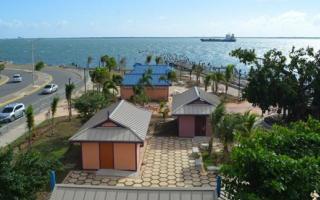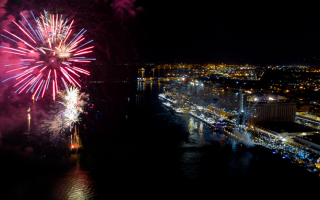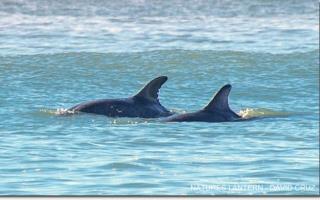Local people pivotal to new Goat Islands plan

Both the Urban Development Corporation (UDC) and the National Environmental Planning Agency (NEPA) are currently spearheading a five-year management plan to transform Great Goat Island – the larger of the two cays located approximately two miles from the Old Harbour Bay coastline – into a wildlife sanctuary.
The intent of this plan was made known by the state agencies during another round of community meetings at the Old Harbour Bay Community Centre in Blackwood Gardens on March 8.
Friday’s dialogue lasted for roughly three hours and is part of a series of public consultations being jointly held by NEPA and the UDC to raise awareness and seek community involvement and recommendations for the proposal, which will be submitted for grant funding to prospective local and international donors.
Work is schedule to commence April 1, 2019 but will be rolled out on a phased basis over the course of the next five years, with a view of transforming the cay into an eco-tourism venture.
A management committee comprising of stakeholder representatives from NEPA, the UDC, the Natural Resources Conservation Authority (NRCA) and a member from the community is being formalised to oversee its implementation.
More than 30 residents from the community were present at the meeting that was lively, cordial, and productive and not short of ideas.
At the moment several activities of immediate need are to be undertaken, said the UDC and the University of the West Indies Researcher and Environmental Officer, Damion Whyte, who outlined plans in a 30-minute PowerPoint presentation.

According to Whyte, among the most immediate need is the removal of a few wild life animals, such as goats, mongoose, coneys, in order to preserve and protect the flora and fauna that exist. He further added that they intend to return the endangered Jamaican iguanas to the area.
“When we had the last community stakeholder meeting last week, we learnt that there were two gentlemen from the community who used to go over there and feed the goats,” said Whyte. “The goats were actually tamed then. But when these gentlemen died the goats got wild.
“And when you have a lot of wild goats especially on a small island they eat a lot of vegetation including plants that you are trying to protect. So we have a very healthy goat population over there. We will have to work out some of the ways how we can capture some of the goats.”
Like mainland Jamaica, the Goat Islands possess rich history. On the islands exists artifacts left behind by the Tainos, the first original human inhabitants in this region of the Americas. Remnants of old Spanish buildings and English wells built on the island during the 14th and 15th centuries now lie in ruins. The island was also used as a Naval Base during World War II by the Americans, who built an airstrip and buildings which are still visible today.
Half-a-decade ago, the islands were earmarked for the development of a major international logistic hub which ignited into a controversial hot topic between big business interests and environmentalists.
But after reclaiming political power in 2016, prime minister of Jamaica Andrew Holness declared the Goat Islands as a wildlife sanctuary with the Port of Kingston the preferred destination for the much-talked about logistic hub.
“When you think of a wildlife sanctuary it means an area where we protect some of the plants, some of the animals and even some of the cultural artifacts.
“When you dealing with an area that’s a sanctuary you have to come up with a management plan; and that management plan is something that’s going to tell us how we are going to get it done” explained Whyte.
“We come up with some ideas but we need to hear from the community what they think.
“For example when we talk about the goats to get off some of the invasive animals from over there we going to need community members involved. When we talk about the selection of trees that need to put back we need the community. When we talk about tours, we need the community. When we talk about school trips we need the community. So there are a lot of opportunities.”
He added: “When you have a wildlife sanctuary you have a lot of visiting scientists and other people come in the area and who would want to go over there and there are spin-offs for the community members. When they (scientists) come down, they don’t want to stay in no hotel, they want to come in the community.”

Among the many suggestions from the community members is the development of the Old Harbour Bay public beach, the construction of a pier, the establishment of a registry for licensed boat owners to transport members of the public to and from the cay, and a permanent base for emergency rescue personnel.
Amid those excellent ideas, however, came a word of caution from community member Charles Moodie.
“Members of the community must be involved to ensure that certain rights and privileges are not taken away. The community must meet among themselves and decide what’s best,” Moodie, a highly respected figure in the community, warned.
Camille Williams-Cheese, president of the Old Harbour Bay Community Development Committee, expressed optimism but was equally cautious.
“Many times it sounds good when organizations come into the community but after everything is sealed then it’s no longer noted as Old Harbour Bay; it is now the south coast of Old Harbour. So they take away the name of Old Harbour Bay. So we are asking you to please ensure that we retain our name because Goat Island is in Old Harbour Bay,” the CDC president said.
A socio-economic study is currently being worked on to determine the overall impact the wildlife sanctuary will have on the local and national economy in the short, medium and long term, said Sara Simpson, director of natural resources and environmental planning at the UDC.
Old Harbour News is a community-based online news media outlet based in Jamaica with more than 300,000 unique visitors since 2013. However, we are soliciting your support to continue provide independent journalism and unique stories tailored just for you. Your contribution, however small it may be, will ensure our service to you remain independent and grow to serve you better. Click the DONATE BUTTON now to support Old Harbour News. Thank you.

































